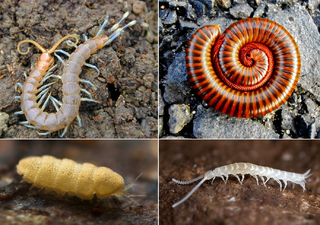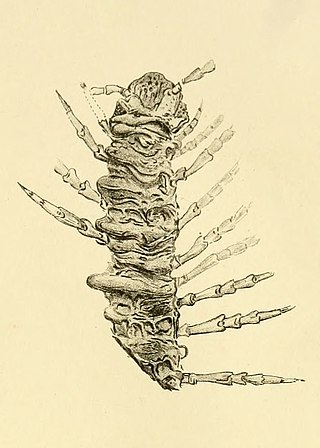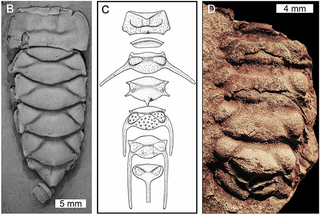
The Devonian is a geologic period and system of the Paleozoic era during the Phanerozoic eon, spanning 60.3 million years from the end of the preceding Silurian period at 419.2 million years ago (Ma), to the beginning of the succeeding Carboniferous period at 358.9 Ma. It is named after Devon, South West England, where rocks from this period were first studied.

The Silurian is a geologic period and system spanning 24.6 million years from the end of the Ordovician Period, at 443.8 million years ago (Mya), to the beginning of the Devonian Period, 419.2 Mya. The Silurian is the shortest period of the Paleozoic Era. As with other geologic periods, the rock beds that define the period's start and end are well identified, but the exact dates are uncertain by a few million years. The base of the Silurian is set at a series of major Ordovician–Silurian extinction events when up to 60% of marine genera were wiped out.

Millipedes are a group of arthropods that are characterised by having two pairs of jointed legs on most body segments; they are known scientifically as the class Diplopoda, the name derived from this feature. Each double-legged segment is a result of two single segments fused together. Most millipedes have very elongated cylindrical or flattened bodies with more than 20 segments, while pill millipedes are shorter and can roll into a tight ball. Although the name "millipede" derives from Latin for "thousand feet", no species was known to have 1,000 or more until the discovery in 2020 of Eumillipes persephone, which can have over 1,300 legs. There are approximately 12,000 named species classified into 16 orders and around 140 families, making Diplopoda the largest class of myriapods, an arthropod group which also includes centipedes and other multi-legged creatures.

Stonehaven is a town in Scotland. It lies on Scotland's northeast coast and had a population of 11,602 at the 2011 Census. After the demise of the town of Kincardine, which was gradually abandoned after the destruction of its royal castle in the Wars of Independence, the Scottish Parliament made Stonehaven the successor county town of Kincardineshire. It is currently administered as part of the Aberdeenshire Council Area. Stonehaven had grown around an Iron Age fishing village, now the "Auld Toon", and expanded inland from the seaside. As late as the 16th century, old maps indicate the town was called Stonehyve, Stonehive, Timothy Pont also adding the alternative Duniness. It is known informally to locals as Stoney.

Myriapods are the members of subphylum Myriapoda, containing arthropods such as millipedes and centipedes. The group contains about 13,000 species, all of them terrestrial.

Arthropleuridea is an extinct subclass of myriapod arthropods that flourished during the Carboniferous period, having first arisen during the Silurian, and perishing in the Early Permian. Members are characterized by possessing diplosegement paranotal tergal lobes separated from the body axis by a suture, and by sclerotized plates buttressing the leg insertions. Despite their unique features, recent phylogenetic research suggests Arthropleuridea be included among millipedes in the class Diplopoda. The subclass contains three recognized orders, each with a single genus.

Galeaspida is an extinct taxon of jawless marine and freshwater fish. The name is derived from galea, the Latin word for helmet, and refers to their massive bone shield on the head. Galeaspida lived in shallow, fresh water and marine environments during the Silurian and Devonian times in what is now Southern China, Tibet and Vietnam. Superficially, their morphology appears more similar to that of Heterostraci than Osteostraci, there being currently no evidence that the galeaspids had paired fins. A galeaspid Tujiaaspis vividus from the Silurian period of China was described in 2022 as having a precursor condition to the form of paired fins seen in Osteostraci and gnathostomes. Earlier than this, Galeaspida were already in fact regarded as being more closely related to Osteostraci, based on the closer similarity of the morphology of the braincase.
The Pragian is one of three faunal stages in the Early Devonian Epoch. It lasted from 410.8 ± 2.8 million years ago to 407.6 ± 2.8 million years ago. It was preceded by the Lochkovian Stage and followed by the Emsian Stage. The most important Lagerstätte of the Pragian is Rhynie chert in Scotland. It is named after the city of Prague. The GSSP is located within the Prague Formation at Velká Chuchle, Prague.
The Lochkovian is one of three faunal stages in the Early Devonian Epoch. It lasted from 419.2 ± 3.2 million years ago to 410.8 ± 2.8 million years ago. It marked the beginning of the Devonian Period, and was followed by the Pragian Stage. It is named after the village of Lochkov in the Czech Republic, now part of the city of Prague. The GSSP is located within the Lochkow Formation at the Klonk Section in Prague.
In the geological timescale, the Llandovery Epoch occurred at the beginning of the Silurian Period. The Llandoverian Epoch follows the massive Ordovician-Silurian extinction events, which led to a large decrease in biodiversity and an opening up of ecosystems.

The Early Devonian is the first of three epochs comprising the Devonian period, corresponding to the Lower Devonian series. It lasted from 419.2 ± 3.2 to 393.3 ± 1.2 and began with the Lochkovian Stage 419.2 ± 3.2 to 410.8 ± 1.2, which was followed by the Pragian from 410.8 ± 3.2 to 407.6 ± 1.2 and then by the Emsian, which lasted until the Middle Devonian began, 393.3± 1.2 million years ago. During this time, the first ammonoids appeared, descending from bactritoid nautiloids. Ammonoids during this time period were simple and differed little from their nautiloid counterparts. These ammonoids belong to the order Agoniatitida, which in later epochs evolved to new ammonoid orders, for example Goniatitida and Clymeniida. This class of cephalopod molluscs would dominate the marine fauna until the beginning of the Mesozoic Era.

Cowie is an historic fishing village in Kincardineshire, Scotland. This village has existed since the Middle Ages, but in current times it is effectively subsumed into the town of Stonehaven. It had an estimated population of 2,720 in 2020.

Polysporangiophytes, also called polysporangiates or formally Polysporangiophyta, are plants in which the spore-bearing generation (sporophyte) has branching stems (axes) that bear sporangia. The name literally means 'many sporangia plant'. The clade includes all land plants (embryophytes) except for the bryophytes whose sporophytes are normally unbranched, even if a few exceptional cases occur. While the definition is independent of the presence of vascular tissue, all living polysporangiophytes also have vascular tissue, i.e., are vascular plants or tracheophytes. Extinct polysporangiophytes are known that have no vascular tissue and so are not tracheophytes.

Archipolypoda is an extinct group of millipedes known from fossils in Europe and North America and containing the earliest known land animals. The Archipolypoda was erected by Scudder (1882) but redefined in 2005 with the description of several new species from Scotland. Distinguishing characteristics include relatively large eyes with densely packed ocelli, and modified leg pairs on the 8th body ring. Some species had prominent spines while others had a flattened appearance.
Cowiedesmus is an extinct millipede genus originally described from the middle Silurian of Scotland, and is considered as earliest known land animals alongside Pneumodesmus from same formation. Although a 2017 study suggested that the geological formation it contains actually appears to be from the Early Devonian (Lochkovian) instead, a 2023 study confirmed the age identification of the 2004 study through palynological, palaeobotanical and ziron analyses incorporating newly discovered additional data. Cowiedesmus was about 4 cm (1.6 in) long and characterized by a greatly enlarged pair of legs on the 8th segment which may have been used in clasping females or functioned as gonopods. Coweiedesmus is distinct enough from other living and fossil millipedes to be placed in its own order, Cowiedesmida. The only known species, C. eroticopodus, was described in 2004.

The Cowie Formation is geological formation located on the Highland Boundary Fault between the fishing village of Cowie and Ruthery Head, in Aberdeenshire, Scotland. Age of this formation is controversial, that was originally estimated at the Middle Silurian, Wenlock to Ludlow, but zircon geochronology shows the Early Devonian, Lochkovian instead. In study published in 2023, according to spore microfossils and additional zircon data, the Middle Silurian, late Wenlock age is suggested again. This formation preserves fossils, including a millipedes such as Pneumodesmus and Cowiedesmus that were discovered by Mike Newman in 2001, and some agnathan like Cowielepis.

Cowielepis is an extinct genus of jawless fish in the class Anaspida. It is from the Cowie Harbour fish bed of Stonehaven, Scotland, which age was originally considered as the Silurian, one study reassigned to Early Devonian (Lochkovian), and 2023 study suggested Wenlock age again.

Kampecaris is an extinct genus comprising the Kampecarida, an enigmatic group of millipede-like arthropods, from the Silurian and early Devonian periods of Scotland and England. They are among the oldest known land-dwelling animals. They were small, short-bodied animals with three recognizable sections: an oval head divided along the midline, ten limb-bearing segments forming a cylindrical trunk that tapered slightly towards the front, and a characteristic swollen tail formed by a modified segment that tapers at its rear into an "anal segment". The cuticle forming their exoskeletons was thick, heavily calcified, and composed of two layers.
The Fish Bed Formation is a geologic formation in Scotland, United Kingdom. The fluvial to lacustrine sandstones, shales, siltstones and conglomerates preserve flora, arthropods, among which eurypterids, invertebrates and early fish fossils dating back to the Wenlock epoch of the Silurian period.

Maldybulakia is a genus of freshwater arthropod which lived during Late Silurian to Late Devonian. Maldybulakia is known from three species, M. angusi and M. malcolmi from Australia, M. mirabilis from Kazakhstan, and M. saierensis from China. Its classification is uncertain, it was originally described as a myriapod-like animal, and later considered related to the xiphosurans, or an artiopod.
















